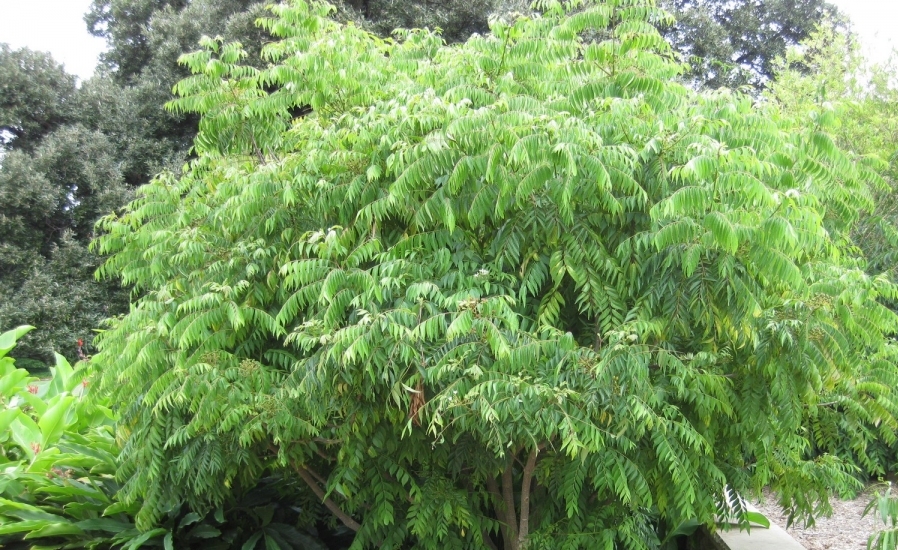Murraya Koenigii

|
|
Murraya koenigii Common Names: Curry Tree, Curry Leaf Tree, Sweet Neem Scientific
Classification Kingdom: Plantae Clade: Angiosperms Clade: Eudicots Clade: Rosids Order: Sapindales Family: Rutaceae Genus: Murraya Species: M. koenigii Authority: (L.) Spreng. Synonyms: Bergera koenigii L., Chalcas koenigii (L.) Kurz Morphological Description Murraya koenigii is a small, tropical to subtropical evergreen tree,
typically growing 4–6 m tall with a trunk up to 40 cm in diameter: · Bark: Smooth, greyish-brown, thin, aromatic when crushed (Fern,
2024). · Leaves: Pinnate, 15–30 cm long, with 11–21 leaflets; leaflets ovate,
2–4 cm long, 1–2 cm wide, glossy dark green, highly aromatic (Barwick, 2004). · Flowers: Small, white, fragrant, 1–1.5 cm long, in terminal cymes;
bisexual, self-pollinating (Govaerts, 2024). · Fruits: Shiny black drupes, 1–1.5 cm long, edible pulp, single toxic
seed (Bown, 1995). Distribution and Habitat Murraya koenigii thrives in warm climates across Asia: · Range: Native to India, Sri Lanka, Bangladesh, Nepal; naturalized
in Malaysia, Thailand, Australia (Govaerts, 2024). · Habitat: Forests, woodlands, wastelands, up to 1,650 m elevation;
prefers full sun to partial shade, well-drained loamy soils (Fern, 2024). · Climate: Optimal at 27–41°C; tolerates 500–2,500 mm annual rainfall
(Barwick, 2004). Ethnopharmacology Murraya koenigii, commonly known as curry leaf, possesses a wide
range of medicinal properties, making it a valuable plant in traditional and
modern medicine. It exhibits strong antioxidant, anti-inflammatory,
antimicrobial, antidiabetic, and hepatoprotective activities due to its rich
phytochemical composition, including alkaloids, flavonoids, phenolics, and
essential oils. The plant has been extensively used in Ayurvedic medicine for
managing diabetes by lowering blood glucose levels and improving insulin
sensitivity. Its hepatoprotective effects help in liver detoxification and
protection against drug-induced toxicity. Additionally, Murraya koenigii is known for its neuroprotective potential, which
may aid in preventing neurodegenerative diseases like Alzheimer's and
Parkinson's. Its antibacterial and antifungal properties make it effective
against various infections, while its cardioprotective effects contribute to
cholesterol reduction and heart health. Furthermore, curry leaf extract has
shown potential in cancer prevention due to its ability to induce apoptosis in
cancer cells. The plant is also beneficial for gastrointestinal health,
promoting digestion and reducing the risk of ulcers. Despite its numerous
health benefits, excessive consumption may lead to mild toxicity, necessitating
controlled usage. · Antioxidant: Leaf extracts (100 mg/kg) reduced oxidative stress in rats
by 35% via flavonoids and vitamins A, C, E (Tachibana et al., 2001). · Antimicrobial: Essential oil inhibited Staphylococcus aureus (MIC 0.5 mg/mL) in Sri Lankan studies
(Sankar Ganesh et al., 2015). · Antidiabetic: Leaf powder (10 g/day) lowered fasting glucose by 16% in
diabetic patients over 4 weeks (Iyer & Mani, 1990). · Anti-inflammatory: Ethanolic extract (200 mg/kg) reduced paw
edema in rats by 40%, comparable to ibuprofen (Gupta et al., 2010).
⚠ Toxicity Profile:
Administration of
Murraya koenigii ethanolic leaf extract for 28 days did not cause structural
damage to major organs. However, at doses of 500 mg/kg and 900 mg/kg, a
reduction in subcutaneous fat was observed during the final two weeks of
treatment. These dose levels also led to decreased total cholesterol and blood
glucose levels, with the most significant effects occurring at 900 mg/kg.
Histopathological analysis revealed mild congestion across all treatment
groups, while haemorrhage and lymphocyte infiltration were noted in male and
female rats at 900 mg/kg. Overall, the extract increased hemoglobin levels and
reduced body weight, subcutaneous fat, and blood glucose levels, particularly
in medium and high-dose groups. Despite some lymphocyte infiltration and haemorrhage,
no major organ damage was detected. (Sakarkar et al., 2017). Additional Uses · Culinary: Fresh leaves flavor curries, chutneys; dried in spice blends
across South Asia (Facciola, 1998). · Cosmetic: Leaf oil in soaps, hair tonics in India (Fern, 2024). · Cultural: Planted near homes in Sri Lanka for spiritual protection
(Bown, 1995). References
External Links More Pictures |
|
| Compounds of Murraya Koenigii |
|
| References |